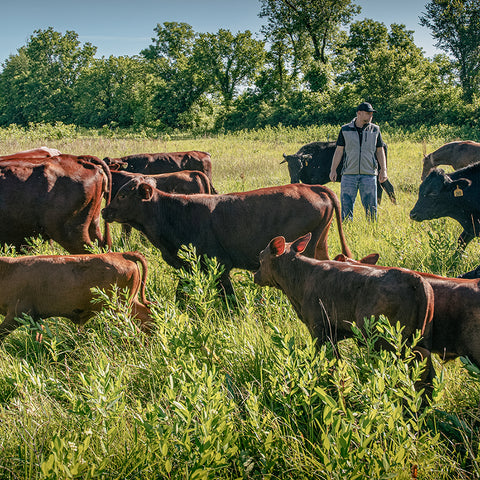The meat industry has had its fair share of detractors over the past decade (and often with good reason). The way animals are treated, raised and processed have been called into question (as they should be, accountability is a good thing), but few scalable solutions to the problems have been proposed. That’s starting to change now that more consumers are considering the impact of their food on the environment, their health and wildlife. Today, as a regenerative company we are seeing rapid growth in the interest of regenerative raised meat, which is quickly becoming next big food trend... and it's being driven by consumers.

Regenerative agriculture regenerates and rebuilds topsoil
There’s a growing movement in agriculture to shift our food production away from chemically dependent monoculture crops, overcrowded feedlots and back to regenerative farming — an agricultural system that focuses on returning as much organic matter back into soil as possible through rotational grazing.
First, the term regenerative does not specifically refer to the food itself; it refers to the restoration of topsoil, soil microbes and overall biomass. Healthy soil is brimming with microscopic organisms that generate a virtuous cycle of rich, healthy plants and animals. One of the negative effects of industrial farming is soil health decline over time. This decline in soil quality isn't only a meat issue. Organic farms that aren't using animals to replenish the soil nutrients in their fields and orchards are also depleting soil nutrients faster than they are regenerated. The nutritional value of an an organic apple today can be 50% less than an apple grown in that same orchard 60 years ago due to the quality of the soil.
Chemical fertilizers are short-term solution to a long-term problem, not unlike putting a temporary band-aid on a deep wound. However, if the soil is fertile and healthy in the first place, its microbes will synthesize those nutrients in good time.

What is “regenerative” and how do I recognize it?
Currently, finding and purchasing regenerative meat requires some critical thinking and research. There's no current governmental regulation on regenerative agriculture, this results in many companies that utilize this term for marketing purposes only. They want the benefits of the term without implementing the processes that makes a farm truly regenerative. And let's be honest, running a regenerative farm requires more time and labor.
Nonetheless, there are a number of third-party certifications gaining momentum, and farmers are beginning to adopt them due to their positive impacts on the soil. Today, leaders are emerging who can assess their regenerative practices, methods and resources to enhance the confidence of consumers. The Savory Institute, verifies that our ranches are regenerating soil and bases that verification on a data-driven ecological outcome-based scoring system. This third-party verification system holds us accountable and makes us truly a regenerative meat company. The Savory Institute attributes the Land to Market Seal for brands that have demonstrated and proven regenerative outcomes.

Regenerative agriculture helps to reduce atmospheric carbon
More than the health of soil, plants, and animals, regenerative agricultural practices improve the health of our planet. What's the purpose of buying healthy meat if the natural world around us continues to get sicker? One of the ways this happens is by sequestering carbon, and for this reason alone, regenerative practices are necessary for the future of agriculture. Without oversimplifying, more carbon in the soil translates to less carbon in the air, and healthy soil has proven to be one of the planet's best carbon sinks. For every one pound of certified regenerative meat, one can sequester up to 3.5 pounds of carbon from the atmosphere. That thought process makes a strong connection with conscious consumers and it's working to make their lives better and the planet healthier.

Ruminant animals are the MVPs of regenerative agriculture
Fertilizer. This one is pretty obvious, right? Most of us will quickly identify manure, and all its other synonyms, as a major benefit of livestock. As animals are strategically grazed through pastures and perennial spaces, they leave behind this natural fertilizer. Instead of shipping in a big load of fertilizer like many farms do, grazing animals that are continually moved to new grass will gradually deposit smaller amounts over time. Ruminant's hooves also breakup and aerate hardened soils and trample down old growth preparing the way for new plants to spring up. Lastly, they convert plants into clean protein that humans can consume to power active lifestyles.

Regenerative Meat is delicious. You can taste the difference.
In the interest of deliciousness, we strive to deliver delicious tasting food that fulfills ethical criteria for regenerative animal proteins. Ultimately, we believe regenerative products are those that should leave you feeling good about what you're eating, from a nutritional and ethical standpoint.
If a food tastes bad, you're probably not going to eat it — and even if you do, you likely won't feel good about what you've eaten or want to repeat that experience often. The best part is that regenerative animal proteins are truly delicious, raising animals on biodiverse pasture, in their natural setting results in the healthiest and cleanest meat in the market today.





Comments (0)
There are no comments for this article. Be the first one to leave a message!